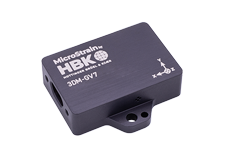| Newsletter February 24, 2011 |
|
|
|
|
New Inertial API Offers Unprecedented User Control
Last month, we announced the launch of our newest inertial sensor, the 3DM-GX3-35, a high precision AHRS with an onboard GPS. The 3DM-GX3-35 sensor features a new application programming interface (API), giving users more control over their data. It offers:
- Customizable data messages for selecting specific quantities at mixed data rates
- Synchronized time stamp allowing attitude and GPS data to be correlated in time
- New packet protocol for improved data integrity
- Ability for users' to write their own host based Kalman filters specific to their application

The real benefit to users is more accurate, tailored, and robust data, as well as options to eliminate extraneous information. Additionally, while the new API is ready for the next generation of integrated inertial sensors, it is backward compatible, allowing users to leverage existing code with minimal modification.
To learn more about the new API and to view data communications protocol, click here.
|
Wireless Sensing: Quick Start Video Guides for  Node Commander
With the release of Node Commander 2.0, several improvements have been implemented. To help you get started with the new software quickly, our support team has put together a series of videos.
Video 1 - General Communications Video 4 - Legacy Low Duty Cycle Video 2 - Node Configuration Video 5 - Synchronized Sampling Video 3 - Real Time Streaming Video 6 - Armed Data Logging
|
|
| |
|
|
|
Tech Tips & Tricks: Using the 3DM-GX3-25 Capture Gyro Bias Function
The factory calibration of the 3DM-GX3 -25 removes any gyro bias at the time of manufacture. However, gyro bias error may creep in over time due to a number of factors including switch-on to switch-on, bias drift, effects of shock (g level), circuit noise, calibration errors, etc. The Capture Gyro Bias function of the 3DM-GX3 -25 allows the user to easily remove these bias errors and correct the gyro output at any time.
|
MicroStrain Presenting at HUMS 2011 in Australia
MicroStrain President and CEO, Steve Arms, will be presenting on Flight Testing of Wireless Sensing Networks for Rotorcraft Structural Health and Usage Management Systems on March 1 from 2:15 - 2:30 at HUMS 2011 in Melbourne Australia. The focus of the conference is on health condition and usage monitoring systems that are most suited to ensuring availability, reliability and safety of critical and high-value assets. HUMS 2011 is held in conjunction with the 14th Australian International Aerospace Conference from February 28th through March 3rd.
For more information, or to register for the event, click here.













